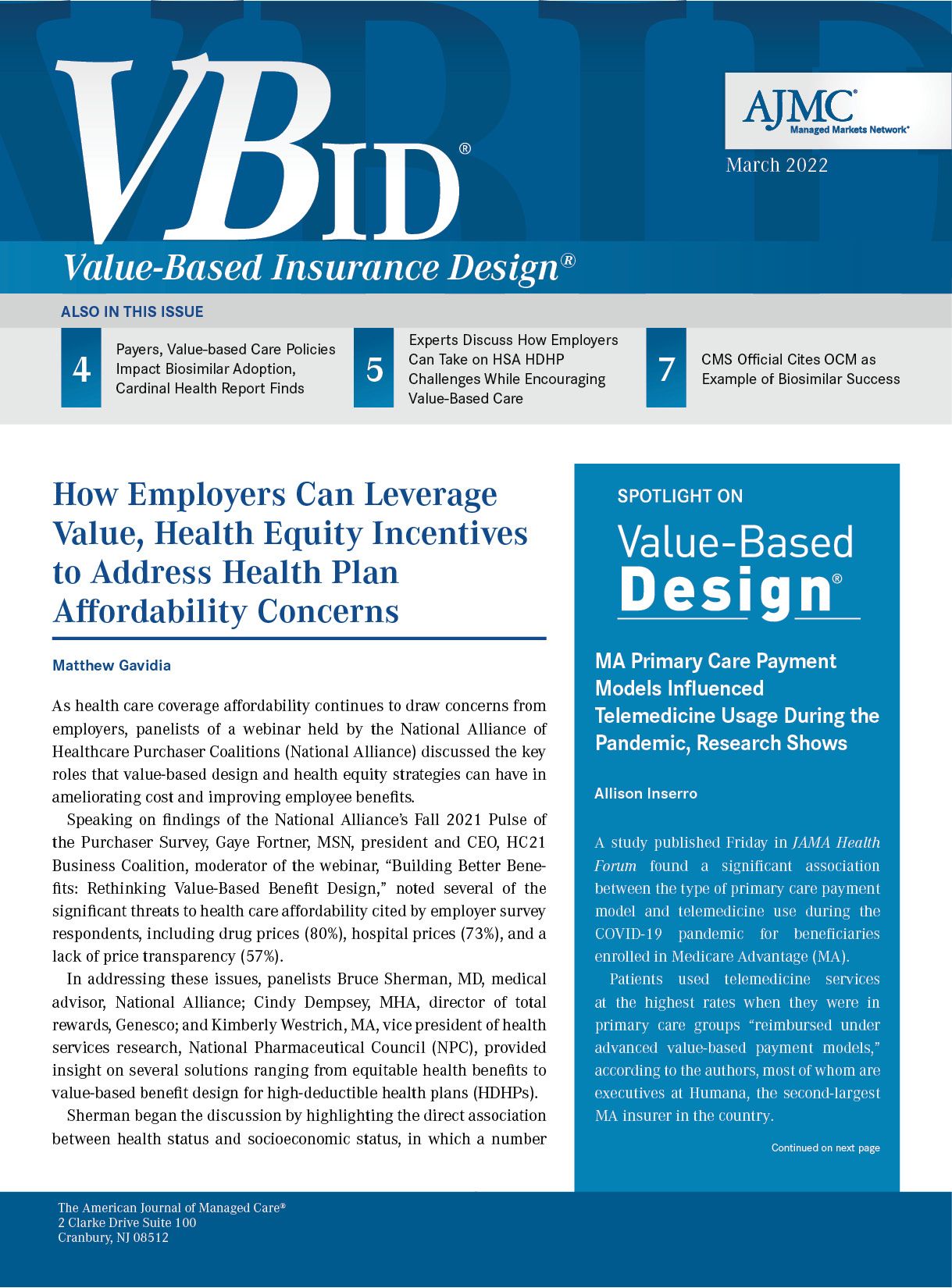Publication
Article
VBID® Value-Based Insurance Design® Newsletter
Payers, Value-based Care Policies Impact Biosimilar Adoption, Cardinal Health Report Finds
Author(s):
Cardinal Health's report, “2022 Biosimilars Report: The U.S. Journey and Path Ahead,” outlines how biosimilars will move beyond their comfort zones in oncology and rheumatology and more boldly into therapeutic areas such as ophthalmology and diabetes care.
Payers and value-based care policies have had more impact on the adoption of biosimilars than their inclusion in clinical care guidelines, according to a new report from Cardinal Health examining the biosimilars landscape and forecasting their use in 2022.
Bruce Feinberg, DO, vice president and chief medical officer for Cardinal Health Specialty Solutions, writes that Cardinal's 2018 prediction that payers could make or break the biosimilars market turned out to be “prescient.” Some steps by payers helped the cause of lower-cost versions of biologics, while others seemed to defy logic.
Overall, the new report, “2022 Biosimilars Report: The U.S. Journey and Path Ahead,” offers an optimistic view of the landscape. The overview outlines how biosimilars will move beyond their comfort zones in oncology and rheumatology and more boldly into therapeutic areas such as ophthalmology and diabetes care.
But much of the year will spent preparing for the disuption to come in early 2023, when Humira, the top-selling drug in the world, will face competition from up to 7 biosimilars, with more in the pipeline.
The year 2022 “is set to be a turning point,” in the United States, the report states, with biosimilars poised to deliver $133 billion in aggregate savings by 2025.
“Total savings to patient out-of-pocket costs based on just the current biologics with biosimilars approved are estimated to reach up to $238 million,” predicted Heidi Hunter, president, Cardinal Health Specialty Solutions, in the report’s final section, which offers predictions.
Cardinal Health’s overview offered a primer on the landscape since the first supportive care biosimilars came on the scene in 2015, noting that specialists in oncology and, to a lesser degree, rheumatology have gained experience with these products, and provider survey data contained in the report reflects this familiarity.
As Feinberg explained, biosimilars have already shaped the market, especially where payment models have supported their use. He offered the example of the Oncology Care Model in Medicare, which has rewarded participating practices for taking advantage of savings from biosimilar use.
“Significant progress has been made in the adoption of biosimilars in the U.S., particularly in oncology, where all 3 classes of therapeutic oncology biosimilars (i.e., rituximab, bevacizumab, and trastuzumab) have exceeded 60% market share,” the report found. “Savings from biosimilars increased to approximately $8 billion in 2020 alone, more than tripling savings derived from previous years. In addition, for the first time in 7 years, oncology expenditure growth fell below 10% due to the impact of biosimilars and new product launches.”
By contrast, Feinberg wrote, “Commercial payers and pharmacy benefit managers (PBMs) initially impeded biosimilar adoption in oncology in the early years of biosimilar availability, but as coverage has improved in recent years, market uptake of oncology biosimilars has similarly increased.”
The report predicts 5 trends for 2022, starting with a call to watch for market response to the approval of Viatris’ Semglee (insulin glargine-yfgn). While 2021 did not have many biosimilar approvals, this approval of the first interchangeable insulin, a biosimilar for the reference product Lantus, was a major newsmaker.
Cardinal Health’s report states that how payers, PBMs, and retail pharmacists react Semglee will tell the market a lot about the value of the FDA designation for interchangebility, which allows pharmacist substitution without prescriber approval. “As a result, pharmacists are now positioned to not only play an essential role in educating patients and ensuring clinical confidence in biosimilars, but also to serve as key change agents who may steer millions of diabetes patients to high-quality, lower-cost treatment options,” the report states.
Other predictions for 2022 are:
- Manufacturers will protect their positions as Humira (adalimumab) faces competition from up to 7 biosimilars next year, and other rheumatology and immunology drugs prepare for biosimilar competition.
- Although biosimilars for retinal care will continue to get attention, overall uptake in this area will be slow even as the number of patients with wet age-related macular degeneration rises and costs per treatment are $2000 on average. Byooviz (ranibizumab-nuna), the first biosimilar in ophthalmology, is expected to launch in June 2022.
- The Biden administration’s executive order for biosimilar approval transparency along with market transparency will help the cause. Rulemaking from FDA and actions by the Federal Trade Commission will support competition, and so will a new approach to payment models that promote biosimilar use in Medicare.
- An increased emphasis on real-world evidence will provide particular insight into the effects of switching therapies.
While Cardinal’s report states that the best is yet to come for biosimilars, it shows products have already climbed on providers’ radar. Cardinal Health’s provider survey finds that those providers who have used biosimilars the most have increased their comfort level with the products—even when switching patients to biosimilars during curative treatment. Among the survey findings:
- In the 4 specialist categories surveyed—oncologists (N = 323), rheumatologists (N = 102), ophthalmologists (N = 102), and diabetes care specialists (N = 54)—only the ophthalmologists reported less than half (40%) being “very familiar” with biosimilars. Outside of ophthalmology, more than 90% of the specialists were “very familiar” or “somewhat familiar” with biosimilar therapies.
- 67% of oncologists said they would prescribe biosimilars to a patient having success on a reference product regardless of payer considerations, while rheumatologists (35%) and diabetes care specialists (72%) were more likely to prescribe to existing patients if this was required by a payer or PBM.
- More than 7 of 10 oncologists said they were “very” or “moderately” comfortable with automatic substitution of biosimilars, and only 5% said they would not subscribe biosimilars for indications without clinical trial data.
- More than 90% of oncologists said they are comfortable with switching between biosimilars at least in some cases.
Cost savings to both patients and a practice are considerations for providers, although its degree of importance may vary. However, two-thirds of rheumatologists say that the economics of prescribing remain a barrier to biosimilar adoption.
The report describes “momentum” around bringing biosimilars to market as strong, and that the trend to move beyond oncology and rheumatology will define the next 5 years.
“The year ahead is sure to include many significant biosimilar milestones,” the report states.






